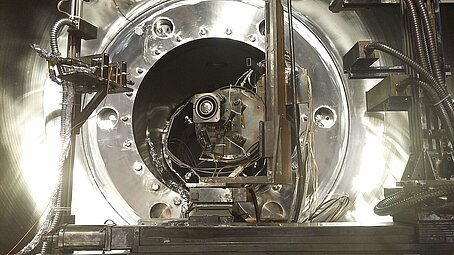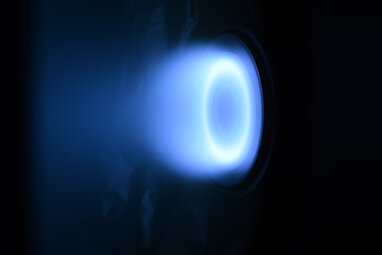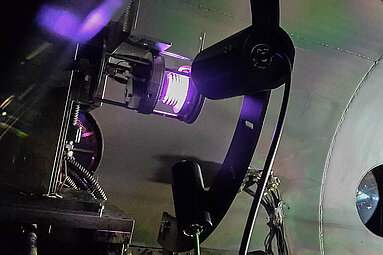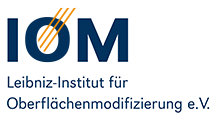The purposeful development of beam and plasma tools requires an in-depth understanding of the physical processes involved. On the experimental side, this can be achieved by characterizing the tools using (in-situ) beam and plasma diagnostics that in part is developed at the Institute. Examples are faraday probe (arrays), retarding potential analyzers as well as in-situ diagnostics for optical and thermal imaging or non-tactile surface profilometry that are based on adapted commercial components. The range of diagnostic tools has recently been extended with the non-intrusive methods of laser-induced fluorescence (LIF) spectroscopy for the determination of ion velocities as well as two-photon laser-induced (TALIF) spectroscopy for quantifying ground state densities of atomic and molecular plasma species. The portfolio of available diagnostic tools is complemented by a variety of commercial equipment.



Expertise
- Development and adaption of diagnostic tools for the characterization of beam and plasma sources
- Characterization of beam and plasma sources, for example, with respect to temperature or ion induced erosion
- Quantitative determination of beam and plasma parameters
- Time-resolved optical characterization of plasma in the nanosecond regime
Diagnostic methods
Selection
- Laser induced fluorescence spectroscopy
- Two-photon absorption laser induced fluorescence spectroscopy
- Streak camera
- Ultra high speed plasma imaging
- Optical emission spectroscopy
- Faraday probes and arrays
- Retarding potential analyzer
- Energy selective mass spectrometry
- Telemicroscopy (source monitoring)
- Laser profilometry (source monitoring)
- Pyrometry (source monitoring)
- Thermal imaging (source monitoring)
Highlights
Two-Photon Laser-Induced Fluorescence in a Radiofrequency Ion Thruster Plume in Krypton
C. Eichhorn, F. Scholze, C. Bundesmann, D. Spemann, H. Neumann, H. Leiter
Journal of Propulsion and Power 35 (2019) 1175
https://doi.org/10.2514/1.B37487Gridded ion engines apply an electrically biased extraction grid system in order to accelerate ionized particles, which, in this way, form the „propellant“ of the device. An intact grid geometry, in particular the preservation of the grid hole diameters, is a basic requirement with regard to the long-life cycle of such thrusters used in spaceflight applications. The knowledge of spatially resolved densities of plasma species near the thruster exit plane is important for a quantitative estimation of plasma- and surface processes that may lead to undesirable grid hole widening (grid hole erosion). This work demonstrates how neutral particle densities of a relevant propellant (krypton) can be experimentally measured during thruster operation using non-intrusive techniques based on laser spectroscopy.
An advanced electric propulsion diagnostic (AEPD) platform for in-situ characterization of electric propulsion thrusters and ion beam sources
C. Bundesmann, C. Eichhorn, F. Scholze et al.
Eur. Phys. J. D 70 (2016) 212
https://doi.org/10.1140/epjd/e2016-70236-0Experimental characterization is an essential task in the development, optimization and qualification process of electric propulsion thrusters or ion beam sources, because it allows verifying that the thruster or ion beam source fulfills the requested mission or application requirements. Furthermore, it can provide parameters required for thruster and plasma modeling. In addition, there is a need for standardizing electric propulsion thruster diagnostics in order to make characterization results of different thrusters as well as measurements performed in different vacuum facilities reliable and comparable. Therefore, an advanced electric propulsion diagnostic (AEPD) platform was developed that allows a comprehensive in-situ characterization of electric propulsion thrusters (or ion beam sources) and could serve as a standard on-ground diagnostic tool in the future. The AEPD platform uses a five-axis positioning system and provides the option to use diagnostic tools for beam characterization (Faraday probe, retarding potential analyzer, ExB probe, active thermal probe), for optical inspection (telemicroscope, triangular laser head), and for thermal characterization (pyrometer, thermocamera). Here, the capabilities of the diagnostic platform are described and first experimental results of the characterization of a gridded ion thruster RIT-μX are shown.
On how to measure the probabilities of target atom ionization and target ion back- attraction in high-power impulse magnetron sputtering
M. Rudolph, H. Hajihoseini, M. A. Raadu, J. T. Gudmundsson, N. Brenning, T. M. Minea, A. Anders, D. Lundin
J. Appl. Phys. 129 (2021) 033303
https://doi.org/10.1063/5.0036902The internal discharge parameters, the probabilities of target atom ionization and target ion back-attraction, are two important parameters for understanding high power impulse magnetron sputter processes. The work gives a description of how to obtain these parameters from experiments. Using this method HiPIMS processes can be optimized in an efficient way.
Quantitative low-energy ion beam characterization by beam profiling and imaging via scintillation screens
S. Germer, F. Pietag, J. Polak, T. Arnold
Rev. Sci. Instrum. 87 (2016) 113301
https://doi.org/10.1063/1.4964701The ion beam etching of insulating materials typically requires using a neutralized ion beam to avoid up-charging. Under these conditions, the measurement of the ion beam density distribution via Faraday probes is hampered. Such electrical measurements may also be affected by charge exchange processes that result in the production of fast neutral atoms which contribute to ion beam etching but cannot be detected by charge-sensitive measurements. In this study, single crystal YAG:Ce (Y3Al5O12) scintillators monitored by a CCD camera were used to image the energy deposition of a neutralized low-current ion beam from a broad beam ion source via the scintillation light. To validate the presented beam diagnostic tool, Faraday cup measurements and test etchings were performed. Argon ions with a typical energy of 1.0 keV were emitted from an inductively coupled radio-frequency (13.56 MHz) ion beam source with total currents of some mA. Different beam properties, such as, lateral ion current density, beam divergence angle, and current density in pulsed ion beams have been studied to obtain information about the spatial beam profile and the material removal rate distribution. We observed excellent imaging properties with the scintillation screen and achieved a detailed characterization of the neutralized ion beam. A strong correlation between the scintillator light output, the ion current density, and the material removal rate could be observed.
Projekte
CHEOPS-VHP-BB
The global space community is increasingly interested in planetary exploration of the Moon and Mars, near-Earth asteroid avoidance, mining and in-orbit service missions. In the CHEOPS-VHP-BB project, an international consortium consisting of seven partners – leading representatives of the space industry, research centres, universities and SMEs – is developing innovative technologies to enable future Mars, Moon and near-Earth asteroid avoidance missions. The main objective of this project is to design, develop and qualify future propulsion systems and simulation tools for this purpose, thus complementing ongoing development activities with research and development for the future use of very powerful hall thruster propulsion systems. The project takes a robust and cost-effective approach to qualification, the production of key components subject to wear and the possibility of using alternative propellants and energy sources. The cost-effective approach to qualification envisaged in this project requires the modelling of life-limiting wear processes for selected thruster components. In order to correlate wear with thruster operation, a comprehensive characterization of the thrusters in ground tests is required. For this task, the Advanced Electric Propulsion Diagnostic Platform developed at IOM in two previous ESA projects is used. To do this, beam diagnostic tools must first be adapted to the high thermal load under beam exposure from these very powerful Hall thrusters.
Link: www.cheops-vhp-bb.eu
Duration: 2023 – 2025
Funding (whole consortium): 1,499,853.00 Euro
Funding (IOM): 142,333.75 Euro
Funding programme: HORIZON-CL4-2022-SPACE-01
Coordination: Safran Spacecraft Propulsion, FrankreichConsortium partners: 7
Contact:
Dr. Daniel Spemann
Field of research Tools
Phone: +49 (0)341 235-2681
E-Mail: daniel.spemann(a)iom-leipzig.deLaserspectroscopic characterization of neutral and erosion atoms in the inter-grid region of gridded ion thrusters

Grid erosion is a dominating factor limiting the lifetime of gridded ion thrusters. Erosion is mainly driven by charge exchange processes between ions and neutrals of the operating gas (propellant), resulting in a species of slow ions, which have trajectories that do not follow the ion optics design and lead to sputtering of the grid surface by ion impingement. Within this project, neutral densities of xenon and krypton, and of eroded species such as carbon or molybdenum are measured specifically within the inter-grid and near the exit plane of a gridded ion thruster using laserspectroscopic methods. The inter-grid area is identified with the main region from where charge exchange processes contribute to the ion thruster accelerator grid erosion. Besides ion thrusters, the data may be also important for numerical modeling of ion sources in terrestrial applications.
Duration: 2021 – 2024
Funding: 321.659,27 Euro
Funding programme: Bundesministerium für Wirtschaft und Energie (BMWi)
